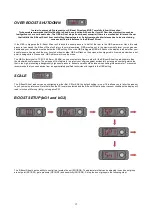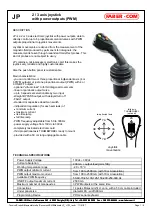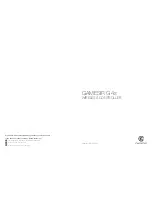
17
RPM DISPLAY CONFIGURATION
If you have connected the yellow RPM wire to an RPM signal from your ECU or negative terminal of an ignition coil you will need to
input the number of cylinders / rotors in order to configure the RPM signal correctly i.e. the number of pulses per revolution being picked
up from the RPM output of the ECU. The number of cylinders available is between 1 and 16. The RPM input can accept a square wave
signal between 3.5 and 12V. For Mazda Rotary engines, 13B and 20B engines can be configured as 4 and 6 cylinders respectively.
LIGHT DIM
The brightness of the display can be adjusted on a scale of 0
– 6. The display can also be dimmed automatically by earthing the orange
wire when the
vehicle’s light system is switched on and setting the scale to 0.
SWITCH LOGIC
The switch logic determines how the E-Boost Street switches between boost groups BG1 and BG2. It is factory set to internal switching
(ISP) where boost groups are changed by pushing the knob. Alternatively, boost groups can be switched remotely when the switch logic
is set to external switching (ESP). By earthing the green wire using a switch, you can toggle change from SP1 to SP2. Un-earthing this
wire will return the set point back to SP1.
AUXILIARY OUTPUT
The e-Boost Street has an auxiliary output function designed to control an auxiliary device once a certain boost pressure or RPM value
is reached i.e. water spray, water injection, warning light or nitrous controller. This circuit can be used to control a
resistor type
automotive relay
with a maximum current draw of 2 amps.
There are four options
bOn
,
bOF
,
rOn
and
rOF
. The boost setting on (
bOn
) and off (
bOF
) value will be entered in the units that are
currently selected for display. Between the
bOn
and
bOF
values the auxiliary output circuit will be closed and therefore will switch the
relay on.
The RPM setting on (
rOn
), and off (
rOF
) are entered as RPM x 100 e.g. if 5000 RPM is the desired setting the user will input 050.
Between the
rOn
and
rOF
values the auxiliary output circuit will be closed.
If the
bOF
or
rOF
is set to zero there will be no off and the circuit will remain closed until boost or RPM drops below the
rOn
or
bOn
value. If using a boost setting only to switch the relay the RPM parameter values should be set to zero to turn off or vice versa.
If using the auxiliary circuit as a nitrous controller, you can enter all four user definable parameters
bOn
,
bOF
,
rOn
, and
rOF
. The
auxiliary circuit will be closed when boost and RPM fall with the window created by these four parameters. That is when boost pressure
is between
bOn
and
bOF
AND
when RPM is between
rOn
and
rOF
.
BOOST CORRECTION
This function is use to reduce or eliminate boost drop off at high RPM. Switching this function on will display the boost correction menu
in the boost group menu. This function is best performed on a chassis dyno where the graph of the boost curve can be displayed and
accurately interpreted.
The boost correction function requires 3 parameters to work; the START RPM, the END RPM and the correction factor.
START RPM (RP1): This is the engine RPM at which boost begins to drop off.
END RPM (RP2): This is the engine RPM at which you want to turn off the boost correction function, normally set at redline.
Correction factor (FAC): The percentage at which boost is dropping off between the START and END RPM.
Bof
Bon
Ron
Rof
AU on in
window




































